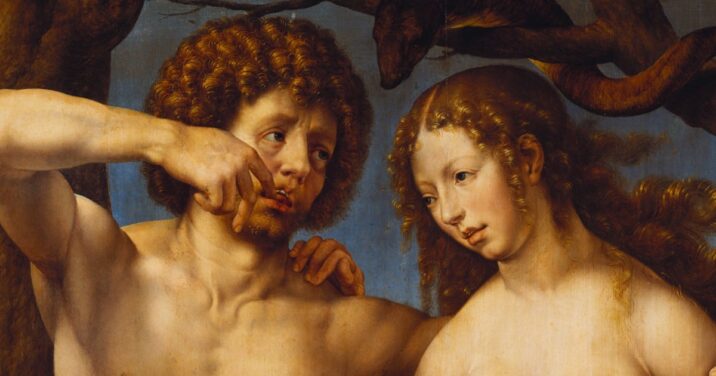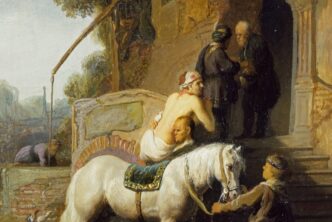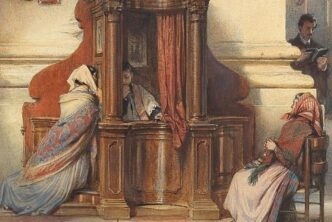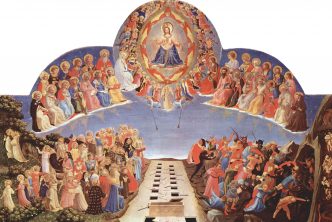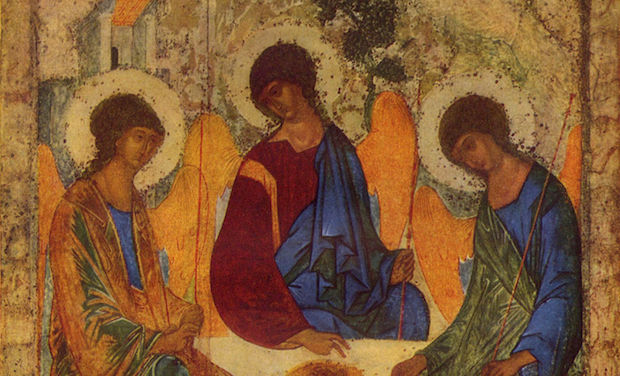What is the Theology of the Body and why should you care? Whether or not you’ve ever heard the phrase “theology of the body” or not, you can be sure that it has influenced and shaped your current understanding of the Bible, the sacraments of the Catholic Church, and has answers to the major moral questions of our day regarding marriage, the Church, sexuality, love, the family, and even heaven itself.
Over the last thirty years, this teaching has transformed the way we understand and address difficult sexual moral issues, to be sure. But it would be tragic to reduce this teaching to mere morality. Its depth and power lie in the clarity of its revelation of the truth and meaning of the human person: your humanity and mine.
Morality is the necessary focus on how we ought to act, but we act in accord with who we think we are. Actions are, in a certain sense, a revelation of who we think we are in the deepest part of our being, the heart. Therefore, it is essential that we cultivate and nurture what we hold as the deepest truth about ourselves: That we don’t settle for partial truths, much less outright lies about who we are, and remain curious, fascinated, and restless to know the fullest vision of ourselves as human beings. It’s only in this knowing of who we are that we can become what we are: fully alive. It’s only with fascination and wonder that we can develop true reverence for both creation and Creator.
So, who are you? Why are you here? Why did God create you with a body, male or female? Does any of it matter? In truth, we’ve struggled with the meaning of our bodies throughout all human history. Individual desires for love, affection, safety, belonging, respect, and flourishing are legendary. Universal struggles with our body-ness are seen across every culture and age. But what do these desires of my heart have to do with my happiness, fulfillment, and flourishing? At the heart, these are crucial questions of identity, relationship, and vocation. And it is in times of crisis and turmoil that we most urgently need to answer these questions. As Pope St. John Paul II has said, “This theology of the body is the basis of the most appropriate method of … man’s education.”
On December 8, 1974, then-Cardinal Archbishop of Krakow, Karol Wojtyla, put pen to paper in his private chapel. He was determined to provide a context to understand both the problems of, and solutions to, the latest social and sexual revolution upending the modern world. On this Feast of the Immaculate Conception, in the presence of Our Lord in the Blessed Sacrament, he began a “theology of the body” by inscribing on the top of his first page, Tota pulchra est Maria: “Mary is all-beautiful.” He would not complete his reflections until “the year of three popes” in 1978, just days before becoming the first non-Italian pope in over four centuries. The world would know him as Pope John Paul II.
This was a project that would synthesize not only decades of his work, thought, and life as a man, a Catholic priest, a philosopher, and a poet, but also that of nearly two thousand years of biblical wisdom on the truth of human love: human love in God’s divine plan. A defense of the then-recently concluded Second Vatican Council in general and the 1968 papal encyclical Humanae Vitae in particular, this new book would draw from the very words of Jesus an ode to man, the body–person made in the image and likeness of God, male and female (Gen 5:2). With an early working title of Human Love in the Divine Plan, these extended meditations on our origin, history, and destiny would ultimately be titled Man and Woman He Created Them: A Theology of the Body (TOB). But not by its author, because he never published it.
On a Wednesday, September 5, 1979, in his second year in office, Pope John Paul II stepped onto the balcony overlooking St. Peter’s Square and began a brief address after the traditional Angelus prayer, as popes occasionally did over the millennia. This time, however, he began what would be a systematic teaching to the pilgrims and visitors to Rome that would not conclude until November 28, 1984. Over those five years, the Holy Father gave these “audiences” week after week (with some noteworthy breaks), with few, other than the Vatican newspaper L’Osservatore Romano, capturing his weekly lectures. But many took notice of his extensive biblical reflections on Genesis, Song of Songs, Matthew, John, Ephesians, Corinthians, and dozens more, and a curious new phrase he repeated over fifty times: “theology of the body.”
Though several major sections audiences were compiled in book form in the 1980s, the first full volume of this Theology of the Body would not appear until 1997. It would take another nine years before the entirety of this work would be researched, recompiled, and retranslated into what we now have as Male and Female He Created Them.
Since 2006, thanks to the tireless research of Dr. Michael Waldstein and the passionate popularization around the world led by Dr. Christopher West, we have witnessed a transformation in the way we learn, understand, and live our Catholic faith. Initially this new catechesis, now popularly known simply as The Theology of the Body, caught fire addressing and answering major moral questions around sexual ethics: marriage, chastity, celibacy, contraception, artificial reproductive technologies, etc. These were the most difficult teachings of our faith for modern people. They were hungry for healing, understanding, and help.
Eventually, the full flowering of the breadth and depth of these catecheses would draw more fully from their roots to explain the meaning of the body itself, the human person, love, the priesthood, as well as the spousal meaning of the Bible, the Sacraments, the Mass, prayer, and even Christ himself as Bridegroom and the Church as his Bride—and more besides!
The Theology of the Body provides a compelling and coherent explanation of the why behind the what of moral questions crossing the threshold of dead-letter religious rules we must follow to proposals we are invited to “come to know” with our own lived experience as a witness. The classical “thou shalt not” language now has a “could this not be” invitation accessible to the modern mind long-closed to objective, deductive, and principled styles of proclamation.
Now fluent in the language of the modern culture, the Church can be church. She can prophesy and actually be heard! Providentially, this “subjective turn” had been the noted approach of young Karol Wojtyla decades before its eventual adoption by the Second Vatican Council. His deep faith in God and his Church formed him unafraid to hold the seeming contradictions such as evil in a perfect God’s world, man as body and soul, love and lust, desire and holiness, and sex and celibacy. He was a man who described himself as “in love with human love,” discovering communion in the male-female relationship as “the deepest substratum of human ethic and culture” (TOB 45:3). His lifelong focus would be on the human person not merely as an object, but as a subject—the subject, in fact.
Of course, the subjects of the salvation story (creation, fall, redemption) are God and man. All proper laws—divine, moral, etc.—have their origin in subjectivity: subjects in relationship with one another, God within himself, God and man, man and woman. (In direct opposition to “subjectivism,” of course, which wrongly declares man as arbitor and self-creator!)
This was put to the test during the sexual revolution of the 1960s that violently rejected centuries of wisdom and truths about man and these relationships, and replaced them with radical new ideas on how we ought to live to be happy. The outright rejection of sexual mores, moral order, right authority, marriage, family, God, religion, masculinity, femininity, freedom, and even the body itself deeply changed the social imagination of believers and non-believers alike. That crisis remains now more than ever. Enter a Theology of the Body.

The words of Christ
In the broadest terms, the 133+ Theology of the Body “audiences” Pope St. John Paul II delivered from that balcony are organized into two major parts.
The first part (often referred to in and of itself as a Theology of the Body) uses the very words of Christ in three moments in the Gospel of Matthew, where he appeals to the origin, the history, and the destiny of man. His appeal to these ages of humanity encourages us to ponder the experience of being in the garden of Eden ourselves, or the power of a renewed ”purity of heart … freeing us from the law” now in sin-soaked history, or the mystery of our “glorified body” united with the Second Person of the Trinity for eternity.
Notice how such a pondering sacramentally unites the seen and unseen—what is, what was, and what will be! Developing this sacramental vision in and through the human body is perhaps one of the most sublime fruits of a Theology of the Body:
The body, in fact, and only the body, is capable of making visible what is invisible: the spiritual and divine. It was created to transfer into the visible reality of the world, the mystery hidden … in God, and thus to be a sign of it. (TOB 19:4)
Origin
From our Lord’s words in Matthew (19:4–6) on the permanency of marriage, he takes us back “to the beginning” with a clear reference to Genesis 1–3. For these first twenty-three reflections, we are invited to meditate on the experience of “original man” in the time before the entrance of sin and shame. These provide some of the most beautiful and memorable insights into God’s tender, generous Fatherhood, and our ineffable dignity, worth, and happiness.
The human body, with its sex—its masculinity and femininity—seen in the very mystery of creation, is not only a source of fruitfulness and of procreation, as in the whole natural order, but contains “from the beginning” the “spousal” attribute, that is, the power to express love: precisely that love in which the human person becomes a gift and—through this gift—fulfills the very meaning of his being and existence. (TOB 15:4)
History
Audiences 24–63 builds on the beautiful purity of our origins and propose a great hope no longer rooted in the law or strict adherence to the law, but on a heart free from the law.
Our Lord’s words from Matthew 5 on lust begin the reflections on historical man; that is, man living in the reality of sin and shame since the fall in Genesis 3. Not free, of course, to break the law, but free with a purified heart that seeks the goodest good transcending the need or purpose of any law or external ethic.
Destiny
Audiences 64–72 round out this first part of The Theology of the Body with Christ’s appeal to our divine destiny (“eschatological man”) taken from his words in Matthew 22. This builds on that exalted origin and history to show the exalted destiny of man in heaven as an eternal union with God.
Summary
Together these form three panels of a “triptych” of the human person using the very words of Christ to provide what Pope St. John Paul II refers to as an “adequate anthropology” (TOB 13:2; 14:3; 15:1; 23:3; 25:2; 26:2; etc.). Simply, the fullest vision or word on who man is that is a worthy foundation for discovering our identity, relationships, and mission: who we are, whose we are, and why we are here.
Nearly half of the entire The Theology of the Body is laying this foundation of the identity of man spoken by the perfect man, Jesus Christ, who came not only to reveal God to man, but man to himself.
The Sacrament
If the first part of The Theology of the Body can be understood as “the Words of Christ” establishing an adequate anthropology, the second part of The Theology of the Body can be understood as the sacramental application of that adequate anthropology to our vocational calling and to the moral law.
Here Pope St. John Paul II meditates on the two great states of life:
- celibacy for the sake of the kingdom of heaven
- marriage
With this adequate anthropology, the Pope proposes these two states of life not as conflicting or contradictory, but complementary. Each is only truly understood in light of the other. Each leads to the same destiny: eternal union with God. Each vocation in its unique and complementary way is a state of life where we live out the “spousal” meaning of the body, the gift of self, and the call to holiness through love as a communion of persons.
These two dimensions of the human vocation are not opposed to each other, but complementary. Both provide a full answer to one of man’s underlying questions: namely, the question about the meaning of “being a body,” that is, the meaning of masculinity and femininity, of being “in the body” a man or a woman. … On the basis of the same spousal meaning of being, as a body, male and female, there can be formed the love that commits man to marriage for the whole duration of his life, but there can be formed also the love that commits man for his whole life to continence “for the kingdom of heaven.” (TOB 85:9, 80:6)
Here is also some of Pope St. John Paul II’s greatest work in helping us understand two inseparable dimensions of marriage: from man’s view to God and from God’s view to man.
Marriage from God’s view is a means of covenant and grace, and from man’s view, marriage is an enduring sign of the entire salvation story. Man is the fruit of the eternal triune communion (“Let us make man in our image and likeness” [Gen 1:26]), with capax dei (“capacity for God”), yet made sexual—male and female—with the capax to enter into our own free, total, faithful, and fruitful communion of persons in God’s image and likeness, not as just an end in itself but as a school of love preparing us for the reality that the sign of marriage points to: eternal union with God himself.
Christ the Bridegroom and the Church as the Bride are betrothed to “marry” and live eternally (outside of time!) in a mysterious, glorious, one-flesh union. This sacramental vision invites us to perceive the dignity of marriage and its irreplaceable role in God’s plan for salvation: God wants to marry us (Hos 2:2). From the natural marriage of our first parents in Genesis to the supernatural wedding feast of the Lamb in the last book of the New Testament, we now recognize marriage as a lens to understand salvation history as a love story—the love story.
This proper horizon resists the loss of reverence for the sign of marriage and making it an idol—a source and summit for our good. All signs, including the effective sign of marriage, take their dignity from the reality that they point to. In this case, the marriage of man and woman takes its dignity from the eternal union of Christ the Bridegroom and the Church as his Bride. And like every good sign, it ultimately yields to the reality.
Finally, drawing from all that he has proposed thus far, Pope St. John Paul II concludes the final audiences of his Theology of the Body reflecting on the encyclical Humanae Vitae (On Human Life) from his predecessor Pope Paul VI. This monumental 1968 document boldly reaffirmed the Church’s teaching of God’s condemnation of contraception as a grave evil against the moral law.
Here, The Theology of the Body provides the anthropological, vocational, sacramental, human, and divine context to understand contraception as a contradiction to—a literal “speaking against”—the language of the body in the sexual embrace. This language of the body is nothing less than the marital vow promised in words at the altar: “I am yours, and you are mine.” Marriage itself, rightly understood (and redeemed from our diminished modern practice), is a unique love established by the mutually-exchanged vow to be a free, total, faithful, and fruitful communion of persons.
Sexual union is marital because it is a unique re-presentation of that wedding vow spoken in the language of the body. The “lie” of contraception is the attempted withholding of self during an act whose marital nature is total self-gift. In the vocabulary of Humanae Vitae, the contraceptive act overlays itself onto the unitive and procreative nature of the marital act.
It would be a heavy, difficult, perhaps even controversial closing to The Theology of the Body if we make the mistake of jumping right to these final audiences looking just for the rules or the law. But filled with the wisdom and truth of the preceding 117 audiences, pondering the beauty of human love in the divine plan, these moral conclusions finally make sense. They have a human and divine context that move them from rules imposed on us to the radical demands of love. We are invited to do for love what we would never do for the law.
Perhaps that is the greatest gift of The Theology of the Body: It is a fresh, compelling invitation to know, love, and serve God, ourselves, and others in this world and the next.
In 2006, I overheard Dr. Waldstein describe the early controversial reception of The Theology of the Body: “There are those who love the approach but hate the conclusions, and those who hate the approach but love the conclusions.”
I love them both, and invite you learn and love them also.
Resource your interest in the Theology of the Body
Related articles
- How to Make a Good Confession
- How to Study the Bible Like a Catholic
- Mortal and Venial Sins: What They Are & What to Do About Them
- What Are the 7 Sacraments of the Catholic Church?


